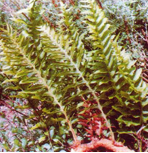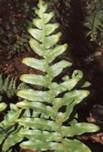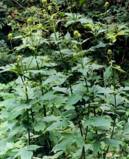Drynaria and Dipsacus
yang tonifying herbs for bones, tendons, and brains
Drynaria and dipsacus are extensively used in modern Chinese practice for the same purpose as over the previous centuries: treatment of injuries and various disorders of the bones, tendons, and joints; frequently, they are combined together for these applications. Because of their history of use, most research on formulas that include them, the individual herbs, or their isolated active fractions has focused on the treatment of osteoporosis or bone fracture. Studies in laboratory cell cultures and in animals support their beneficial effects on bones in terms of stimulating the osteoblasts (1-3). Recent reports indicate that these two herbs may be of value in prevention of senile dementia, including dipsacus used for Alzheimer’s disease.
DRYNARIA
 Drynaria is a fern, and its rhizome has been used in medicine for over a thousand years. It was named gusuibu for its purported ability to mend broken bones (gu = bones; sui = broken; bu = mend). While the main species identified in the market has been Drynaria fortunei (= Drynaria roosii; = Polypodium fortunei), there is increasing reliance on the species grown in Sichuan Province, Drynaria propinqua. A good rendition of the uses for drynaria rhizome in the traditional medical system is given by Ou Ming (4): “Tonify the liver and kidney, activate blood circulation and expel wind-dampness. For deficiency of liver and kidney or sluggishness of blood circulation manifested as rheumatism and weakness of the back and knees, and kidney deficiency syndrome manifested as toothache, dizziness, tinnitus, or chronic diarrhea. Restores bones and tendons: for fracture and trauma.”
Drynaria is a fern, and its rhizome has been used in medicine for over a thousand years. It was named gusuibu for its purported ability to mend broken bones (gu = bones; sui = broken; bu = mend). While the main species identified in the market has been Drynaria fortunei (= Drynaria roosii; = Polypodium fortunei), there is increasing reliance on the species grown in Sichuan Province, Drynaria propinqua. A good rendition of the uses for drynaria rhizome in the traditional medical system is given by Ou Ming (4): “Tonify the liver and kidney, activate blood circulation and expel wind-dampness. For deficiency of liver and kidney or sluggishness of blood circulation manifested as rheumatism and weakness of the back and knees, and kidney deficiency syndrome manifested as toothache, dizziness, tinnitus, or chronic diarrhea. Restores bones and tendons: for fracture and trauma.”
 An example of its application for promoting bone strengthening is found in a clinical study of osteoporosis patients. The formula administered was said to be comprised of a decoction liquid with (5):
An example of its application for promoting bone strengthening is found in a clinical study of osteoporosis patients. The formula administered was said to be comprised of a decoction liquid with (5):
| Dryanria | 16 grams |
| Psoralea | 16 grams |
| Eucommia | 16 grams |
| Rehmannia | 20 grams |
| Astragalus | 20 grams |
| Codonopsis | 16 grams |
| Licorice | 6 grams |
A new area of drynaria applications came about when researchers sought to counteract the adverse effects of some drugs that cause impairment of the kidneys and may also produce symptoms characteristic of the “kidney” disorders defined in Chinese medicine, such as problems with hearing. It was reasoned that herbs benefiting the kidney might counteract such adverse effects of drugs. Drynaria was shown to provide protection from side effects of streptomycin and kanamycin (these produce symptoms of headache, tinnitus, and deafness). A study showing protection against hearing-related side-effects of gentomycin also showed that the drynaria flavonoids did not counteract the antibiotic activity of the drug (6). Further work with laboratory animals indicated that drynaria flavonoids could protect against drug-induced renal failure, leading the researchers to claim that (7): “the flavonoid fraction prevents nephrotoxicity, improves kidney function, and promotes kidney primary epithelial tubular cell regeneration.”
Drynaria has become the subject of increased attention in China after evidence was presented that it may help in treatment senile dementia. From the TCM point of view, the bones, kidneys, and brain are all linked together as part of the kidney essence, so these applications can make sense from that type of analysis. In one report, it was said that increasing the dosage of drynaria to 120 grams (in decoction) per day yielded good results in an Alzheimer’s disease patient who had been treated with a variety of herbal formulas previously without substantial effect (8).

 Most of the current studies of drynaria involve the flavonoids, either as a complete extract or isolating individual components. Among the flavonoids of drynaria is naringin (left), which has the best known source in grapefruit, and epiafzelechin (right), which is currently under investigation as an anti-inflammatory agent and inhibitor of herpes simplex virus.
Most of the current studies of drynaria involve the flavonoids, either as a complete extract or isolating individual components. Among the flavonoids of drynaria is naringin (left), which has the best known source in grapefruit, and epiafzelechin (right), which is currently under investigation as an anti-inflammatory agent and inhibitor of herpes simplex virus.
DIPSACUS
 Dipsacus refers to the root of Dipsacus asper (= Dipsacus asperoides), from a small plant Family, the Dipsacaceae. The Chinese name, xuduan, means to reconnect (xu) that which has been severed (duan). It is traditionally used not only for broken bones, but also for ruptured tendons and for broken skin (such as a deep cut).
Dipsacus refers to the root of Dipsacus asper (= Dipsacus asperoides), from a small plant Family, the Dipsacaceae. The Chinese name, xuduan, means to reconnect (xu) that which has been severed (duan). It is traditionally used not only for broken bones, but also for ruptured tendons and for broken skin (such as a deep cut).
 The roots contain phenolic acids (such as caffeic acid, cinnamic acid derivatives, vanillic acid, and caffeoylquinic acid); several iridoid glycosides, including loganin, cantleyoside, triplostoside A, and sweroside derivaties; and triterpenoids, such as oleanic acid, akebiasaponin D, and a series of unique asperosaponins.
The roots contain phenolic acids (such as caffeic acid, cinnamic acid derivatives, vanillic acid, and caffeoylquinic acid); several iridoid glycosides, including loganin, cantleyoside, triplostoside A, and sweroside derivaties; and triterpenoids, such as oleanic acid, akebiasaponin D, and a series of unique asperosaponins.
Sample Application of Dipsacus
One of the difficult medical problems today is dealing with elderly persons who suffer from hip fractures that are slow to heal. The prolonged immobility contributes to worsening health and, in many cases, death. In the English-Chinese Encyclopedia of Practical Traditional Chinese Medicine volume on orthopedics and traumatology (9), a formulation is relayed for this type of problem:
| Zhuangjin Yangxue Tang | |
| Dipsacus | 12 grams |
| Rehmannia | 12 grams |
| Tang-kuei | 9 grams |
| Angelica | 9 grams |
| Achyranthes | 9 grams |
| Moutan | 9 grams |
| Cnidium | 6 grams |
| Carthamus | 5 grams |
| Eucommia | 5 grams |
This combination (xuduan, shoudu, danggui, baizhi, niuxi, mudanpi, chuanxiong, honghua, duzhong) is decocted as a one day dose. The group of dipsacus, eucommia, achyranthes, and rehmannia is commonly used for persistent back and leg disorders. The formulation nourishes kidney and liver and vitalizes blood.
BONE, MARROW, AND KIDNEY ESSENCE
In a report on clinical use of a formulation for osteoporosis, the following explanation was provided for the theory of building the bones, as well as the function of certain herbs that might be used (10):
TCM theory holds that “the kidney dominates the bone and generates the marrow,” “the essence of life is stored in the kidney, the essence generates the marrow which nourishes the bone; and the bone generates the marrow congregation of which forms the brain.” It is stated in Plain Questions [Nan Jing] that “the bone and the kidney are interior-exteriorly related and “the qi of the marrow is stored in the kidney.” These works indicate that the bone and the marrow are dominated by the kidney. The bone is strong and powerful when the kidney essence and qi are rich; conversely, when there is a shortage of kidney essence and qi, there will be lack of bone marrow and the bone is weak, while in severe cases “the loin and the spinal column cannot be straightened and the bone is withered with decreased marrow, resulting in bone flaccidity.”
Traditional medicaments have showed alleviation of symptoms and increase of bone tissue density, demonstrating that these remedies possess the actions of preventing the bone from losing its tissues, alleviating symptoms, and delaying deterioration of osteoporosis. In our prescription, dipsacus, morinda, and loranthus are used to warm the yang, benefit the kidney, and strengthen bones and tendons; rehmannia, placenta, and cornus nourish the kidney essence, strengthen the bone and marrow, and benefit blood and yin; and drynaria and schizandra consolidate and increase the essence, and strengthen the kidneys and bones. The above drugs used together can tonify the kidney to strengthen the bone. Observation of therapeutic effects of traditional kidney tonifying medicaments has further verified the TCM theory that the kidney dominates the bone and generates the marrow and that osteoporosis can be treated and prevented by traditional means.
This description demonstrates the pre-technological nature of Chinese medicine and its terminology, in that “marrow” has been referred to quite used loosely due to lack of detailed knowledge of the body constituents. The marrow is the portion of the bone structure that is involved in generating blood cells. By contrast, the part of the bone that maintains the hard, mineralized structures is the osteophytes, which are distributed throughout the bony structure. If we read the term “marrow” in the TCM literature as referring broadly to the living components of the bone, the explanation then fits reasonably well. Also, the term kidney, though pointing to the organs at the lower spine, refers here to something different that the organ involved in eliminating waste. One can say that the vitality of the cells associated with utilizing their original DNA coding corresponds to the kidney qi and essence. With aging, cells tend to become less functional; this comes both from interior changes (slow degradation of components) and surrounding changes (lower levels of hormones and other substances that stimulate the activity of the cells). Thus, osteoporosis is prevented by exercise (“weight bearing exercise”) that stimulates the osteophytes and by hormones, especially estrogen in women, that maintain the osteophyte activation; lack of physical activity and lower hormone levels are primary reasons for accelerated bone loss with menopause.
According to the TCM framework, the spinal cord and brain are “extensions” of the kidney, said to be part of the “marrow” and tied to the bones. Association of osteoporosis and Alzheimer’s disease (11), which has been noted repeatedly during the past decade, may provide some support for the TCM connection between brain and bone, and, eventually, produce a modern explanation for the substances and processes that connect the two. Since 1999, Chinese and Korean researchers have investigated the effects of dipsacus saponins in protecting neurons and, in particular, reducing neuronal death caused by amyloid proteins associated with Alzheimer’s disease (12–14). Thus, the use of drynaria and dipsacus for protecting neurons and reducing the progression of Alzheimer’s disease is likely to be the subject of more investigation in the near future.
Herbs used to strengthen bones involve warming the kidney. Both dipsacus and drynaria have such a warming (yang tonifying) quality. With menopause, symptoms of heat are often experienced, and this would seem to contradict the use of kidney warming therapy. However, the Chinese theory about this is somewhat complex. The condition of heat sensation, such as experience of hot flashes, is not always a sign of a primary heat syndrome. One of the ideas is that as the kidney essence weakens there can be a “floating of yang,” as though the kidney heat escapes upward to produce the hot sensations; this yang can be rooted by maintaining the normal warmth of the kidney. Kidney warming is aided by the use of moistening astringents, such as cornus (shanzhuyu) and schizandra (wuweizi), that were mentioned by the authors, to help retain the essences of the kidney rather than allowing them to either drain out (the yin) or flush upward (the yang). The kidney warming herbs, including morinda (baji), are accompanied by the enriching rehmannia (shoudi, slightly warm) and moistening loranthus (jisheng; neutral).
In the description of an osteoporosis treatment, the ingredient placenta is mentioned; it is virtually unused in the west, partly out of concerns for safety (considering some pathogens that might accompany it). The primary ingredient for osteoporosis formulations in China is deer antler (lurong) or its gelatin (lujiaojiao), which would be used in place of placenta in this case. Deer antler is a bone material that has regenerative capability and thus symbolizes for Chinese medicine experts the restoration of bone and marrow.
References
- Zhang J, et.al., Effects of total flavonoids from drynaria on proliferation, differentiation, cell cycle and apoptosis of osteoblasts in vitro [in Chinese], Zhong Yao Cai 2009; 32(7): 1090–1093.
-
Zhou X, et.al., Promotion of bone formation by naringin in a titanium particle-induced diabetic murine calvarial osteolysis model, Journal of Orthopedic Research 2010; 28(4): 451–456.
- Liu ZG, et.al., The osteoprotective effect of Radix Dipsaci extract in ovariectomized rats, Journal of Ethnopharmacology 2009; 123(1): 74–81.
- Ou Ming, et al., Chinese-English Manual of Commonly-Used Herbs in Traditional Chinese Medicine, 1989 Joint Publishing Co., Hong Kong.
- Wang MY, et.al., Clinical observation on 96 cases or primary osteoporosis treated with kidney-tonifying and bone-strengthening mixture, Journal of Traditional Chinese Medicine 2005; 25(2): 132–136.
- Long M, et.al., Flavonoid of Drynaria fortunei protects against gentamicin ototoxicity, Phytotherapy Research 2004; 18(8): 609–614.
- Long M, et.al., Flavonoid of Drynaria fortunei protects against acute renal failure, Phytotherapy Research 2005; 19(5): 422–427.
- Yang DY, Gu Sui Bu — A good drug for senile dementia, Journal of Traditional Chinese Medicine 2005; 25(4): 290–291.
- Lei ilian and Cao Yixun (chief editors), English-Chinese Encyclopedia of Practical Traditional Chinese Medicine volume 14, 1990 Higher Education Press, Beijing.
- Liang L, et.al., Clinical observation on osteoporosis treated with traditional kidney-tonifying medicaments, Journal of Traditional Chinese Medicine 1994; 14(1): 41–44.
- Luckhaus C, et.al., Blood biomarkers of osteoporosis in mild cognitive impairment and Alzheimer's disease, Journal of Neural Transmission 2009; 116(7): 905–911.
- Qian YH, et.al., The effects of the total saponin of Dipsacus asperoides on the damage of cultured neurons induced by beta-amyloid protein 25-35, Anatomical Science International 2002; 77(3): 196–200.
- Kim SS, et.al., Neuroprotective effects of 3,5-dicaffeoylquinic acid on hydrogen peroxide-induced cell death in SH-SY5Y cells, Phytotherapy Research 2005; 19(3): 243–245.
- Zhou YQ, et.al., Akebia saponin D, a saponin component from Dipsacus asper, protects PC 12 cells against amyloid-beta induced cytotoxicity, Cell Biology International 2009; 33(10): 1102–1110.
July 2010